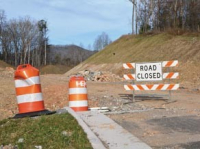Forest users negotiate need for wilderness in new management plan
 Western North Carolina is covered with more than 1,500 square miles of national forest, and residents often measure their assets in terms of towering hardwoods, flocks of turkeys and mountain streams.
Western North Carolina is covered with more than 1,500 square miles of national forest, and residents often measure their assets in terms of towering hardwoods, flocks of turkeys and mountain streams.
National forest land belongs to everybody, but “everybody” includes a pretty diverse group of hikers, bird watchers, hunters, mountain bikers, horseback riders, fishermen, paddlers, environmentalists, loggers and so on — all with different ideas and priorities. As the U.S. Forest Service works toward a new guiding management plan for the Pisgah and Nantahala national forests, it’s a challenge to find a strategy that “everybody” can agree on.
One of the hottest topics? Whether Western North Carolina needs more wilderness.
“Wildernesses are very well loved. We get a lot of use,” said Julia Riber, acting deputy forest supervisor of North Carolina’s national forests. “That’s one of the things we want to hear from folks is does that mean we need more wilderness, and if we have more wilderness, how does that play out with regard to other uses?”
Currently, the Pisgah and Nantahala national forests have six wilderness areas totaling 66,550 acres and seven wilderness study areas — areas with the potential to one day be bona fide wilderness designations — totaling another 8,419 acres.
Related Items
Wilderness areas are Congressionally designated places where “the earth and its community of life are untrammeled by man, where man himself is a visitor who does not remain,” according to the Wilderness Act of 1964. They’re areas where anything with wheels or a motor can’t go and the forest’s natural processes are allowed to continue largely uninterrupted.
Together, wilderness areas and wilderness study areas account for a little over 7 percent of the Pisgah and Nantahala. Brent Martin, southern regional director for The Wilderness Society based in Sylva, believes that number should be higher.
He compares the proportion of wilderness in Western North Carolina to that in nearby national forests such as the Chattahoochee in Georgia, where about 15 percent is designated wilderness. Martin wants to see more protected land in this region. The Wilderness Society has identified about one-third of the Pisgah and Nantahala national forests as North Carolina Mountain Treasures, places believed to have a high conservation value.
“We aren’t recommending that they all be protected as wilderness, but that those areas we have identified as mountain treasures get protected because they do have conservation values,” Martin said. “Best case scenario for us would be that those mountain treasures areas do receive a high level of protection.”
More wilderness and protected land within the national forest is a good idea, Martin said, because it means that there will always be places where natural processes are preserved and the forest can just do its thing.
He also believes wilderness is important for recreation. Existing wilderness areas such as Shining Rock Wilderness Area in Haywood County get some pretty high use, so designating more would spread out those impacts.
“There are super iconic places that are always going to be loved to death because they’re so special,” Martin said, “but I do think that additional wilderness areas could disperse those uses.”
Finding a balance
But when it comes to recreation, wilderness primarily benefits people who enjoy hiking, backpacking, horseback riding and other types of primitive recreation. The Wilderness Act forbids mechanized activities such as mountain biking, off-road vehicle use and logging.
Finding a solution that protects the resource while allowing access to all user groups can be tricky.
“I can’t say I want to see more wilderness, because that means I can’t use that section of the forest as a mountain biker, and that bothers me,” said Chris Strout, president of Pisgah Area Southern Off-Road Bicycle Association. “I’d rather see more inclusiveness than less.”
Strout hopes the new plan will safeguard the forest’s ecology by giving specific sites the protection they need. But he would shy away from sweeping designations — such as wilderness — that keep out certain kinds of users.
Strout’s goal is not necessarily incompatible with Martin’s, however.
Throughout the forest planning process, a coalition representing a cross-section of outdoor interests have been meeting monthly, trying to work out a solution that will leave everyone feeling good. By all accounts, the results are looking positive.
“We’re not coming to the table out of animosity this time,” Strout said. “We’re coming to the table with very clear goals that are not at odds with the forest needs. We all have common ground, and that is just huge.”
The key, Martin said, will be to focus protective designations on places where those designations wouldn’t boot out people who already use the area. Meanwhile, increase opportunities for users such as mountain bikers in other locations.
“I don’t think there has to be a conflict with this as all,” Martin said.
And it’s not just a question of wilderness proponents versus mountain bikers. From horseback riders to hunters to hikers to anglers to logging companies, the national forests are central to a spectrum of outdoor interests, each with its own needs and unique perspective.
Like Strout, David Whitmore, program chairman of the N.C. Bowhunters Association and owner of Headwaters Outfitters, is also leery of recommending additional wilderness areas.
“As an outfitter I don’t want to deter multi-use,” he said, “because those are the folks who come through our forests.”
Managing for wildlife
But as an avid bow-hunter, Whitmore also wants to ensure that the new plan gives wildlife habitat high priority.
“I’m not against what the wilderness designations have now,” he said. “I’d just really like to focus on management, and I fear that these new designations would take away from the wildlife habitat that we have left.”
Some species rely on meadows and young forest habitat for food, meaning that logging can be a good thing for wildlife. With the bigger trees gone, leafy plants, grasses and seedlings spring up, boosting the wildlife food supply. Whitmore worries that, because wilderness doesn’t allow logging, additional designations would reduce the forest’s capacity to support wildlife.
“If you want me to support wilderness areas, make sure you can prove to me the sustainability and health of the wildlife can be met,” Whitmore said. “I don’t see wildlife concerns met other than saying, ‘We need vast area for wildlife,’ and that’s very generic.”
While logging is not allowed on wilderness areas, prescribed fire is, a tool that can also produce the young forest habitat that many wildlife species need. Additionally, the natural death of trees leaves holes in the canopy when the trees fall to the ground, Martin said; wilderness is not incapable of providing that early successional habitat.
“We have a lot of land out there that we can still manage for early successional habitat, so designating more wilderness is not going to lead to mass game declines,” he said. “What I love about wilderness is we can let wilderness do that for us and watch it over time to see how it works without us interfering.”
Whitmore, however, contends that what’s out there now isn’t necessarily wilderness in its natural state. Invasive species and the die-out of important natives like the American chestnut mean that forests have to be more closely managed now in order to stay healthy.
“We’ve done so many things to the forest both on purpose and without,” he said. “If the American chestnut hadn’t died in the 1930s it wouldn’t matter to me, because the animals would have sustainable habitat.”
Now, however, more intentional management is necessary, Whitmore believes.
Collaboration at the core
But managing 1 million acres of forest is a big job. Forest health, user fairness and economic impacts to the logging and recreation industries are all at the forefront, with each decision having different implications to each group. That’s why collaboration will be key to coming up with a forest management plan that works for everyone.
“I think we have to also be sensitive to the needs of the other users that are in there,” said David Lippy, president of Nantahala Hiking Club. “It’s their forest to use, and if one group locks it up to the exclusion of everybody else I don’t think that’s a good idea, because it belongs to all of us.”
But how to make a plan that’s functional and fair? That’s an important question, not least because this plan’s answer will likely stick around for a while. The last forest management plan dates back to 1987, and a lot can change in 29 years. So far, though, the table of people hashing out the issues holds a lot of hope for a positive outcome.
“I think it’s much more desirable for all of us to think that we can get through this as partners,” Martin said. “It’s not going to be easy, but I think we have a good, mature group of people who represent interests in Western North Carolina and that we can come through this together as friends.”
Join the wilderness conversation
A sweeping overhaul of the forest management plan for the Pisgah and Nantahala national forests is a multi-year process, marked with myriad rounds of public comment and public meetings.
The process emphasizes conversation and collaboration, so the next public planning meeting will use a roundtable-type discussion to make some progress on wilderness areas, scenic viewsheds and other special designations.
“It isn’t a public meeting where we’re looking for people to get up and make a statement,” said Julia Riber, acting deputy forest supervisor of North Carolina’s national forests. “We want them talking to each other and to us.”
The meeting will take place at 9 a.m. Thursday, April 17 at the Crowne Plaza Resort in Asheville. Participants will help identify places that the Forest Service could consider recommending as wilderness as well as options for other specially designated areas. At 3 p.m. a drop-in session to discuss the Scenery Management System will begin.
To participate in the wilderness and special designations discussion, RSVP to This email address is being protected from spambots. You need JavaScript enabled to view it. by April 10.









